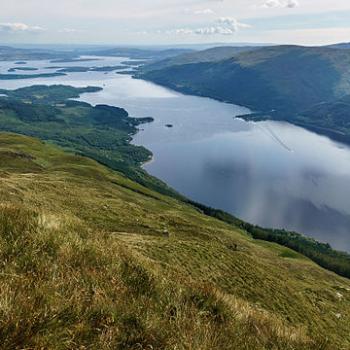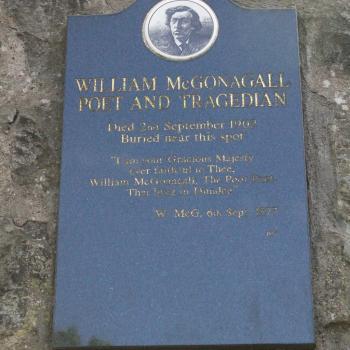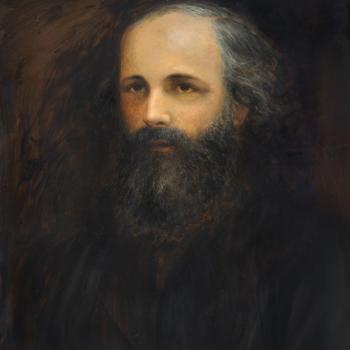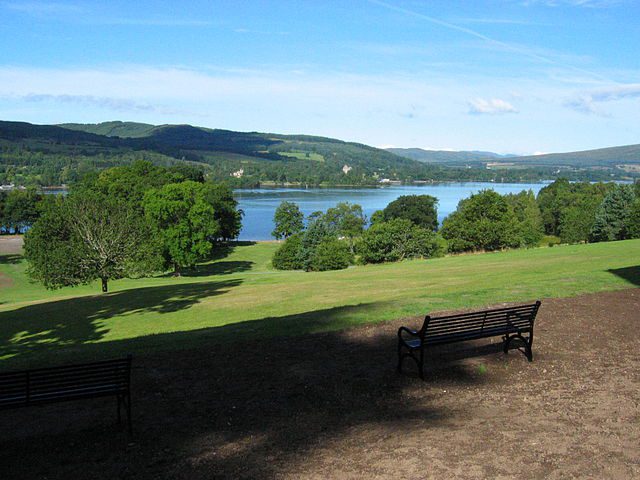
(Wikimedia Commons public domain photograph)
I’m not at all sure why, but, although I’ve visited Scotland on several previous occasions (including that wonderful week in my early twenties at St. Andrews) and although I have an unaccountable affection for the Celtic cross, this is the first time that I’ve really felt the pull of my Scots ancestral line. I’ve long had a deep attachment to Norway, and I’m an Anglophile already, without regard to family heritage. I’m afraid that I’m still working on Denmark. But now, suddenly and unexpectedly, I’m feeling Scottish.
It may, I think, have something to do with the famous Scots song “The Bonnie Banks of Loch Lomond.” I’ve been aware of it for pretty much all of my life, I think, but I somehow didn’t know the story behind it. Knowing it, though, makes sense of it, and makes it (to me, at least) not merely sentimental (as I had thought) but powerfully moving. The song tells the story of two imprisoned Scottish soldiers, perhaps in the aftermath of the bloody and tragic 16 April 1746 Battle of Culloden, which grievously wounded and seriously weakened the Highland clans of Scotland. One of the two soldiers is to be executed, decapitated, while the other is to be set free. According to Celtic legend, if someone dies in a foreign land, his spirit returns to his homeland by “the low road,” which is the route for the souls of the dead.
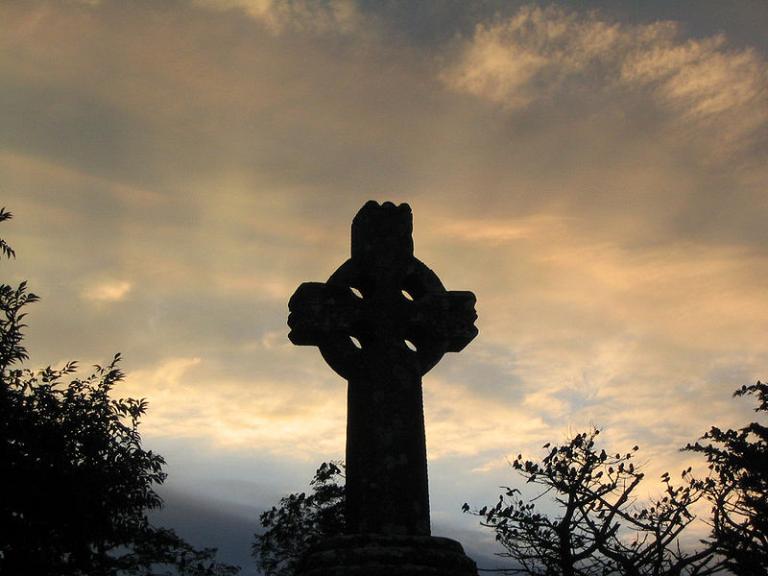
I supply the lyrics below, but here are some notes that should help you to understand them: The adjective bonnie, of course, means “beautiful.” A brae is a steep hillside or bank. Loch Lomond is a freshwater loch or lake, the largest in Great Britain by surface area, that is located about thirty or forty miles to the northwest of Glasgow. The Scottish verb to gae is equivalent to the English verb to go. Ben Lomond (“Beacon Hill”) is a mountain in the Scottish Highlands, on the eastern bank of Loch Lomond; the Ben Lomond near Ogden, Utah, is named after it. Gloaming is an archaic word for “twilight” or “dusk.” The Scots verb to ken is synonymous with the German verb kennen (“to know”). Nae means “no.” Waeful means “woeful.” Frae means “from.”
By yon bonnie banks and by yon bonnie braes,
Where the sun shines bright on Loch Lomond,
Where me and my true love were ever wont to gae,
On the bonnie, bonnie banks o’ Loch Lomond.
Chorus:
O ye’ll tak’ the high road, and I’ll tak’ the low road,
And I’ll be in Scotland a’fore ye,
But me and my true love will never meet again,
On the bonnie, bonnie banks o’ Loch Lomond.
‘Twas there that we parted, in yon shady glen,
On the steep, steep side o’ Ben Lomond,
Where in soft purple hue, the highland hills we view,
And the moon coming out in the gloaming.
Chorus:
O ye’ll tak’ the high road, and I’ll tak’ the low road,
And I’ll be in Scotland a’fore ye,
But me and my true love will never meet again,
On the bonnie, bonnie banks o’ Loch Lomond.
The wee birdies sing and the wildflowers spring,
And in sunshine the waters are sleeping.
But the broken heart it kens nae second spring again,
Though the waeful may cease frae their grieving.
Chorus:
O ye’ll tak’ the high road, and I’ll tak’ the low road,
And I’ll be in Scotland a’fore ye,
But me and my true love will never meet again,
On the bonnie, bonnie banks o’ Loch Lomond.
I share with you here three renditions of the song. The first seems, by the numbers, to be extremely popular, although having it performed by a woman may cloud the original meaning of the lyrics just a bit. (Still, the music video seems to make it work a little, especially with its touching conclusion and its, to me, very congenial suggestion of an eternal, ageless reunion.)
“The Bonnie Banks of Loch Lomond” – Ella Roberts
The second is a performance of the very beautiful arrangement by the English composer Ralph Vaughan Williams (1872-1958):
The third is, well, rather curious:
But all of this has put me in such a Scottish frame of mind and spirit that, as an unasked-for bonus, I’m now going to include the theme “Promontory” from the soundtrack of the 1992 film The Last of the Mohicans. An orchestration by Trevor Jones (and perhaps also Randy Edelman) of the tune “The Gael,” originally written by the Scottish singer-songwriter Dougie MacLean and included in his 1990 album The Search, it’s a big favorite of mine in certain moods. And, ever since I began this cruise, I’ve been increasingly in one of those moods.

(Wikimedia Commons public domain photograph)
Thus far, I’ve given four lectures or led four discussions (whatever it is that I’m doing, it’s somewhere in between the two) aboard this boat, The Jewel of the Seas. I’ve focused to a large extent on the ecclesiastical history of the United Kingdom, both Latter-day Saint and general Christian, accompanied by some relatively lengthy digressions on the history of the English language (beginning with the Angles and the Saxons and continuing on into the linguistic consequences of the Norman conquest and the history and the literary and linguistic influence of the King James translation of the Bible). I’ve devoted special attention to matters such as the emergence of Christianity, the peculiar nature of Christianity in Ireland, the mission of St. Augustine of Canterbury to bring English Christians under the sway of the papacy, the lethal conflict between King Henry II of England (aka Peter O’Toole) and Thomas Becket (aka Richard Burton, or St. Thomas of Canterbury), Henry VIII and the English Reformation, and the Industrial Revolution (as observed by Brigham Young, Heber C. Kimball, Karl Marx, and Friedrich Engels). Obviously, too, I’ve emphasized the mission of Heber C. Kimball to England and the later mission of the Twelve to England, as well as some highlights of the history of the Church since then. It’s fun to think about these things here. And I’ll be thinking a great deal more about them as we begin to pivot toward our Six Days in August project.
Posted from the Hebrides




